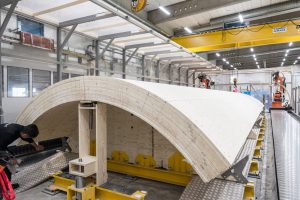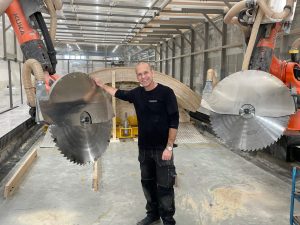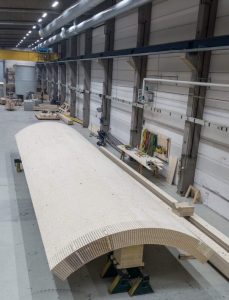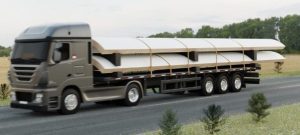The expansion of wind power has been big during the last few years in Sweden. In 2021 alone, over 450 new windmills were built in Sweden. So far all have been built of steel but now wood is available as an optional material. My colleague Torbjörn at the sister-site iSkogen.se visited a factory in western Sweden that builds wind turbine towers of wood.
Wind turbine towers of wood – a company visit
The wood technology enterprise Modvion in Gothenburg is the inventor of this technology and has just started a fantastic journey: From ideas in laboratories to a full-scale industry, ready for the market. Development of knowledge, production methods, and testing materials have been the main targets until now. The first prototype, a 30-meter wind turbine tower, is already in use on an island close to Gothenburg.
For the moment, Modvion works in a new factory called “Factory 1”. Here, the production technique is fine-tuned and in approx. a year, serial production will start in “Factory 2”. The World Market for wind turbines is huge and the arguments to use wood as a material are many.
Photo: Modvion
Company visit
Torbjörn paid the factory a visit in early January. He met one of the founders and partners David Olivegren who was a boat builder who switched to architect/construction contractor and brought his experiences to this new, modern wood industry. Modvion started at Chalmers Entrepreneurship Village where both David and the company’s CEO Otto Lundman were members of the same team.
According to David, the construction of wind turbine towers is the most dynamic wood building in the World today. The shape of the towers is nothing like anything else in traditional wood construction. Towers with circle-shaped bodies that also tapers upwards. Furthermore, this construction is subjected to dynamic loads, unlike a normal building that has static loads. The loads can be very high and come from different directions depending on wind strength and direction.
Photo: Torbjörn Johnsen
Norwegian spruce – perfect for wind turbine towers
One of the major benefits of wood materials is that it is strong in relation to their weight, compared to steel or concrete. Norwegian spruce (Picea abies) belongs to the best wood material in this regard. The problem with wood is that the characteristics differ within a piece of wood which must be compensated with larger dimensions. One way to make the wood more homogeneous and predictable is to slice it into veneer and glue it together again. Just like you do with plywood.
Modvion has chosen to use LVL – Laminate Veneer Lumber (described in this previous article) for their wood towers. LVL is very much like plywood where most of the veneer layers are placed with the fibers in the same direction. This gives very good strength lengthwise and flexibility sidewise. Perfect for windmill towers.
Finnish LVL
Unfortunately (for Sweden) there are no Swedish manufacturers of LVL today, but there are two Finnish, Stora Enso and Metsä. Modvion has had the most rewarding cooperation with both. For the moment Metsä is the supplier of a special quality LVL. The LVL boards are delivered in 15 meter-lengths that form the basis of the construction of the towers. When looking at the boards, you see the top quality. The visible veneer has only fine knots and seems to be cut from densely grown Spruce logs. It looks much better than the plywood you find in the DIY shop. The weight of the LVL boards is approx. 550 kilogram per cubic meter according to David Olivegren.
In the factory, the boards are cut into a conical shape and put together in layers. Those components have 30-centimeter-thick walls of massive LVL. Modvion presses the 15-meter components into a quarter of the cylinder that will become the tower and the components are assembled on the building site. A 100-meter tower has a base diameter of 6 meters and a top diameter of 3 meters. There are no problems making the tower higher. “The sky is the limit” – almost.
Robot with “Terminator-sawblades”
When all the layers are adjusted, they are glued together in an arched hydraulic press. The pressure is released when the glue has dried, and the components are sawn into the exact measurements with two robotic sawblades. These are two industrial robots equipped with one sawblade each. It looks a bit dangerous and like something from a Terminator movie.
The robotic sawblades move along the tower component and trim the edge with a 0.2-millimeter tolerance cut. When the long sides are trimmed, the end sides are trimmed too. After that, grooves and slots for fittings are sawn. This is also made by a pre-programmed robot to get all patterns right in each part of the tower. Each part has a unique pattern depending on the taper of the tower.
30 percent lighter than steel
The tower that was under construction when Torbjörn was there, was for a full-scale wind turbine that will be mounted on a site in western Sweden during the summer. The tower will be 100 meters high and together with the rotor blades the total height will be 150 meters. A large benefit of wood is that it’s light compared to steel meaning it doesn’t demand as much material to carry its own weight.
Photo: Modvion
The wooden towers are mounted on site
When the components, 4 pc. per 15-meter section, arrive on the building site they are glued together into conical cylinders. To get it precise it’s done around a template. The glue is just as strong as the wood material. Each 15-meter cylinder is provided with fittings that are glued into milled grooves. There are many fitting for each cylinder. Before the components leave the factory, they have been coated with a strong Polyurea coating. Only the joints are finished on site.
When all cylinders/parts of the tower are in place it’s time to lift and mount them on top of each other. Each 15-meter module is glued to the one below. The strength has been thoroughly tested over many years to cope with “everything”.
No Swedish wood – yet
When the above-mentioned 100-meter tower is in place in western Sweden, it’s time to enter the market for real. Planning of “Factory 2” is underway and serial production of wind turbine towers is planned to start in 2025. Where “Factory 2” will be located is not yet decided, but quite a few communities have expressed interest in hosting such a modern wood industry.
Modvion has established cooperation with several important players within the wind power and energy businesses. The interest in wooded wind turbine towers is big. E.g., the west coast-based Varberg Energi will own and run the 100-meter wind turbine when it’s ready.
There is for the moment no possibility to use Swedish wood as there are no manufacturers of LVL in the country – yet. Modvion has discussions with several Swedish forest industries and has the feeling that there is an interest to join this journey toward the future. When looking at the World market, the potential for wind turbine towers of wood is huge. Vast volumes of wood will be needed.
Processing and solvency
The Modvion team has a large interest in forestry and not least in the wood market. David Olivegren means that there is too little focus on quality when it comes to Swedish wood materials. To make the LVL quality that Modvion demands, the quality of the spruce logs must be much better than the average today. Special sorting is needed and pricing that makes it profitable for forest owners to sort out the best spruce logs. Something that doesn’t exist today in Sweden. Unlike a sawmill, Modvion processes the wood into high-value products which means they can pay more for the right raw material.
Many good arguments to use wood in wind turbine towers
One argument for using wood in wind turbine towers is that it stores a lot of carbon. When using steel, it’s the opposite. Another benefit of wood is its lower weight which means that smaller dimensions are needed to carry its own weight. The 100-meter tower that is underway has 300-millimeter walls. According to David Olivegren, that provides more than enough strength to the tower. According to the conducted lab tests, it will be possible to build towers with much thinner walls in the future.
Photo: Modvion
When the towers reach this size, the cylindric parts can’t be handled in one piece. They must be manufactured in modules to be transported to and mounted on site. The wooden towers are glued together and after that, no further maintenance is needed. A wind turbine tower of steel is bolted together meaning that there are thousands of bolts that needs inspection periodically. Yet another advantage of wood.
If you wish to reuse wooden wind turbine towers, they are easily converted into strong beams. Of course, also steel can be recycled but it takes more energy.
More info and film
Learn more about Modvion on their homepage here. Here is a short film about the first wind turbine tower, the 30-meter prototype that now stands on the Swedish west coast.
When starting the video above cookies from, among others, YouTube is uploaded. Informed according to GDPR.















